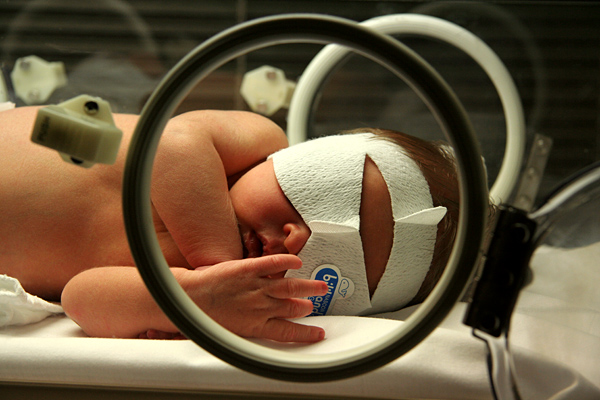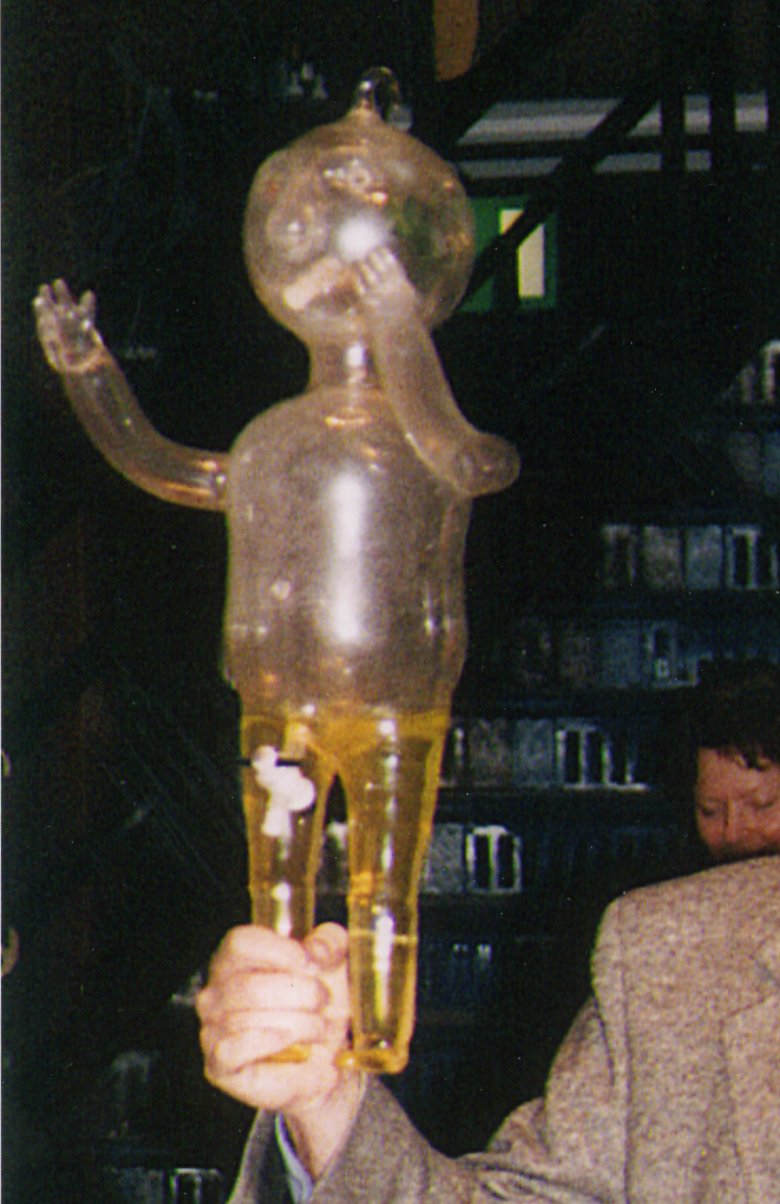Curing Infant Jaundice
Interview with
Chris - We sent along Meera Senthillingham to meet with David Phillips who is at Imperial College to do an experiment that many of us have done a few minutes after we were born.
 Meera Senthilingam: On today's show, we're looking at skin and skin colour, and one colour babies can occasionally go, is yellow when they're suffering from jaundice; and it's long been thought that exposure to sunlight, or more specifically, the blue light in sunlight, can make this colour go away. So this week I've come to Imperial College in London to meet Professor David Phillips in the Chemistry Department.
Meera Senthilingam: On today's show, we're looking at skin and skin colour, and one colour babies can occasionally go, is yellow when they're suffering from jaundice; and it's long been thought that exposure to sunlight, or more specifically, the blue light in sunlight, can make this colour go away. So this week I've come to Imperial College in London to meet Professor David Phillips in the Chemistry Department.
Now firstly David, what actually causes Jaundice in a baby?
David Phillips: Well, we all have a turnover of red blood cells, we destroy the old ones in our body as we make new ones. When the old ones are destroyed they break down to a porphyrin molecule called Bilirubin. Bilirubin is a bright yellow colour and in its normal form it is fat-soluble, so it dissolves anywhere in the body where there is fat. Now in an adult we have an enzyme in our liver and bile which converts that fat-soluble bilirubin into a water-soluble form which allows us to excrete it but a baby does not have that enzyme because it doesn't need it in the womb because the mother does the excretion.
So when the baby is born, it has a problem. It is producing lots and lots of this yellow colour, bilirubin, but it doesn't have the enzyme and you have a lot of fat just under your skin so that's where the bilirubin goes and hence the jaundice.
Meera Senthilingam: Now you've got a very interesting experiment. We've got a glass baby here filled up to its thigh level with a yellow liquid. What's this yellow liquid then?
David Phillips: This is the authentic material which causes jaundice in newborn babies, this is bilirubin which is dissolved in a simulated fat solution, it really represents the jaundice in the newborn baby.
Meera Senthilingam: So what are we going to do now in this experiment?
David Phillips: Well first of all I'm going to give him a drink of water, because I want to show you that the bilirubin will not migrate into the water. It will stay in the fat solution.
So I'm going to lie him down--he is a very unusual baby, he drinks through a funnel and I'm going to insert the funnel into his mouth and then I'm going to pour in about 300 millilitres of water. Then I'm going to hold him up and you'll be able to see that the yellow colour stays in the fat solution, it does not go into the water. This is still water-insoluble bilirubin.
Meera Senthilingam: Yes, you're right. So the yellow fat solution essentially is still there. There are some bubbles on the top and then a clear layer of water on top of that.
David Phillips: So this baby has a problem. If he were left untreated, if it were a real baby, then this can lodge in the central nervous system and before the fifties it caused death in severe cases. Now what I'm going to do, is I've got a little hand-held ultraviolet lamp, which puts out actually quite a lot of blue light; and it's the blue light which is effective, because the yellow solution here, the bilirubin, in it's fat-soluble form is yellow, which means it's absorbing the blue part of the spectrum and the red part of the spectrum. Blue is more energetic than red and so it's the blue light which is the effective light.
So now I'm just going to do irradiate his legs with this blue light for about 2 - 3 minutes.
Meera Senthilingam: So whilst we wait for this blue light to have its effect, there is quite an interesting story as to how this was actually found out about in the first place.
David Phillips: Yes, it was an Essex Maternity Hospital and a nursing sister called Judith Ward, who is in the habit of taking babies out into the sunshine and stripping them down to their nappies, because she thought sunlight was good for them. On one occasion she took a baby back in for inspection on the ward by a physician whose name is Cramer; and when they took the nappy off this Caucasian baby they found that where the nappy had been, he was bright yellow; and so they both realised that sunlight must have converted the bilirubin in some way.
It was very quickly adopted throughout the Western world even though the chemistry was not understood.
Meera Senthilingam: Have there been any developments in understanding of the chemistry behind this?
David Phillips: What we know is it's a very fast reaction. That is, when the light is absorbed the reaction occurs immediately and the most likely candidate is what's called a cis-trans isomerization reaction. There is a carbon=carbon double bond which is locked in a particular position with substituents on the same side of the molecule; that's called the cis form. That represents the fat-soluble form of this molecule; and then when you shine the light on the molecule, it unhinges the double bond which leaves the molecule free to rotate to 180º and then the bond re-forms. Now you've got these substituents on the opposite side--that's the trans-configuration. In doing that you open the molecule up so it presents a carboxylic acid group which is water-soluble to allow the whole molecule to dissolve in water.
In the fat-soluble form that carboxylic acid is buried inside the molecule and so the whole molecule is hydrophobic.
Meera Senthilingam: Okay. So you've been irradiating the baby with the blue light for a while now.
David Phillips: Now what I have to do is to shake him violently to mix the two solutions up.
Meera Senthilingam: Okay. That's good!
David Phillips: Here we go! And now I think as the two solutions separate out I hope you will now be able to see quite clearly that the yellow colour has now migrated into the water layer, just through that photo-chemical reaction.
Meera Senthilingam: Wow! Now that really is extremely impressive. There's been a complete reversal; so up to the thighs which was previously yellow with the fat-soluble solution is now clear; and then the layer which was water above the thighs of this baby are now completely yellow, so it has been 100% reversal of the colour.
David Phillips: Mm-Hmm. Now this little baby can do exactly what you or I do -
Senthilingam - And he is excreting the yellow bilirubin via his urine.
David Phillips: You can now see that this is quite a good demonstration of something that actually occurs. Of course in hospitals you don't use sunlight to do this, we use an artificial blue light which fits over the baby's crib, and usually about a 30-minute irradiation is enough to convert the bilirubin.
Meera Senthilingam: So essentially, David, if a baby is exposed to blue light then, the bilirubin will be filtered out through the kidneys then and be excreted in the urine?
David Phillips: That's correct. In a water-soluble form then it drains away from the skin through the normal drainage processes in the body, down through the kidneys where it's filtered out and then from the kidneys into the bladder and then out in the normal way.
Meera Senthilingam: This treatment with blue light is temporary basically until a baby develops this enzyme that they need?
David Phillips: Yes, a kind of holding operation. A normal baby will develop the enzyme within a day. If a baby is born prematurely or with any liver malfunction, which is really very common, then it might take a lot longer for the enzyme to develop. It's therefore not any good for adults who have jaundice, because that's a clear indication that there's something badly wrong with the liver.
Meera Senthilingam: So this baby has now excreted its bilirubin out and it's now clear and healthy?
David Phillips: Yes, and with any luck, it's developing its enzyme and so it won't need this treatment ever again.









Comments
Add a comment